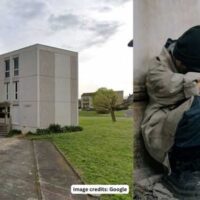A remarkable tale of survival unfolded quietly behind closed doors in the quaint commune of Nersac, nestled in southwestern France. For two years, a young boy, just nine years old, navigated the challenges of daily life without the presence or guidance of an adult. With an astonishing level of independence, he attended school, managed his studies, and maintained his living conditions in near total solitude.
This story raises profound questions about community, vigilance, and the resilience of the human spirit. How could a child so young endure such solitude unnoticed by neighbors and school officials? Here, we delve into the heart of this extraordinary situation, uncovering the layers of this hidden struggle that remained invisible to the very community he belonged to.
The Unnoticed Struggle of a 9 Year Old

In the small French town of Nersac, a young boy faced an unimaginable reality. From the age of nine, he lived alone for two years in a flat devoid of adult supervision, warmth, and basic amenities such as electricity and hot water. Despite these harsh conditions, he managed to maintain an outward appearance of normalcy, attending school regularly and performing well academically.
This boy’s resilience is both heartbreaking and remarkable. He sustained himself on minimal food sources, including cakes, cold canned goods, and occasionally tomatoes he managed to take from a neighbor’s balcony. His survival skills extended to managing his personal hygiene and warmth, often using multiple blankets to sleep during cold nights without heating.
His mother, living only a short distance away, occasionally visited to bring food, but largely left him to fend for himself. This neglect went unnoticed for a considerable period, as the boy continued to attend school where he was seen as a “good pupil,” which possibly contributed to the delay in recognizing his plight. His ability to keep up with schoolwork and maintain a clean appearance masked the severe neglect he was suffering.
The community’s eventual awareness of his situation led to legal consequences for his mother, who was prosecuted for abandoning and endangering a minor. This case brings to light significant issues regarding child welfare and community responsibility in safeguarding vulnerable children.
Community Response and Discovery
The boy’s ordeal in Nersac, while shocking, ultimately highlights the crucial role that communities play in safeguarding children. The neighbors, who occasionally provided food, played a part in sustaining him, albeit unknowingly contributing to the prolongation of his plight by not recognizing the signs of neglect earlier. This delay in recognition is not uncommon in such cases, where signs of child neglect can be subtle and easily misinterpreted.
Research indicates that community awareness and timely intervention are pivotal in preventing child neglect. A study by the U.S. Department of Health & Human Services emphasizes the importance of “community cohesion,” where stronger neighborhood connections can help identify and report cases of neglect more quickly. The report suggests that communities with higher social interaction and surveillance levels are better at safeguarding children against neglect.
In the boy’s case, his outward appearance as clean and well-behaved at school masked his suffering. It wasn’t until a neighbor, after many months, recognized the severity of the situation and reported it, that the authorities intervened. This aspect of the case underscores the need for educational programs that help community members recognize less obvious signs of child neglect.
Furthermore, the role of school staff in such situations is critical. Despite the boy’s regular attendance and good grades, the educators failed to notice his predicament. This raises questions about the training and awareness of school personnel in detecting signs of distress beyond academic performance. Implementing more comprehensive training programs for educators to recognize and respond to potential signs of child neglect can be an essential preventive measure.
The eventual intervention led to legal actions and foster care for the boy, illustrating the process of recovery and justice in cases of child neglect. However, this outcome also serves as a reminder of the gaps that still exist in our social safety nets and the continuous need for vigilance and proactive community engagement to protect vulnerable children.
This story sheds light on a young boy’s resilience and the critical gaps in community and institutional responses to child welfare. It calls for a collective effort to enhance the detection and reporting mechanisms to prevent such cases from remaining unnoticed for so long.
The Resilience of Youth

The psychological impact of neglect on children is profound and multifaceted, affecting various aspects of their development and well-being. The story of the young boy from Nersac, who managed to maintain his schooling and outward normalcy despite severe neglect, offers a stark example of resilience in the face of adversity.
Neglect, particularly in early childhood, can disrupt the brain’s normal development, leading to long-term cognitive, emotional, and social issues. Chronic neglect is associated with a range of developmental impairments that are often more pervasive than those caused by physical abuse. These impairments can include language and cognitive development delays, difficulties in attention and emotional regulation, and challenges in forming healthy relationships.
Despite these potential outcomes, the resilience shown by some children, like the boy in Nersac, is noteworthy. Resilience in this context refers to the ability to thrive and develop positively in the face of hardship and adversity. It is influenced by factors such as individual temperament, the presence of at least one stable and supportive relationship, and the child’s engagement in school and community activities.
Psychological resilience is not merely about bouncing back but also involves substantial growth and adaptation. For children who have experienced neglect, supportive interventions, such as therapy and educational support, can play a crucial role in mitigating the negative impacts and promoting resilience. Effective interventions often include building supportive adult-child relationships, teaching coping skills, and providing emotional and educational support.
The case of the boy from Nersac highlights the critical role of schools and communities in identifying and supporting neglected children. His ability to maintain good grades and a semblance of normalcy likely provided him with a structure and sense of purpose that contributed to his resilience. However, it also masked the signs of his neglect, delaying intervention. This underscores the importance of training educators and community members to recognize the less obvious signs of neglect and respond proactively.
The resilience demonstrated by such children, while remarkable, should not detract from the urgent need for timely detection and intervention to prevent the severe and often hidden suffering that neglect entails.
Legal and Social Ramifications
In France, child neglect carries significant legal consequences, reflecting the seriousness of this issue. When a child is found to be neglected, it can lead to severe legal actions against the responsible parties, including imprisonment. For instance, in cases similar to the one from Nersac, parents can face charges of abandonment and endangering a minor, which can result in substantial prison terms.
Additionally, the French legal system emphasizes the need for comprehensive assessment and intervention once neglect is reported. This involves a multidisciplinary approach to ensure the child’s well-being, taking into account not only the immediate safety but also the child’s long-term physical and psychological health. Laws mandate that professionals from different sectors, such as healthcare, social services, and education, work collaboratively to support the child’s recovery and reintegration.
The case also highlights broader social implications, prompting a reevaluation of community and professional responsibilities in identifying and reporting neglect. It underscores the importance of vigilant and informed communities and trained professionals in safeguarding children’s welfare.
How to Help Prevent Child Neglect in Your Community

Everyone can play a role in protecting children in their community. Here are some practical tips that everyday people can use to make a difference:
- Be Observant: Pay attention to the children in your neighborhood. Notice if a child often appears unsupervised, has frequent injuries, seems underfed, or is improperly dressed for the weather. These could be signs of neglect.
- Learn the Signs: Educate yourself about the signs of child abuse and neglect. Local child welfare agencies often offer resources and training sessions to help community members recognize warning signs.
- Reach Out: If you see a family that seems overwhelmed or in crisis, offer a helping hand. Sometimes, simple acts of kindness like offering to babysit, bringing over a meal, or even just listening to a stressed parent can provide much-needed support.
- Know Who to Call: Familiarize yourself with how to report suspected child abuse or neglect in your area. Keep contact information for local social services, and don’t hesitate to make a call if you believe a child is in danger.
- Support Local Programs: Many communities have family resource centers and prevention programs that need volunteers or donations. Supporting these programs can help strengthen families and prevent neglect before it starts.
- Organize or Participate in Community Events: Community events can foster a strong sense of togetherness and watchfulness. Participating in or organizing events like neighborhood block parties or parent meet-ups can help build connections among neighbors that protect all children.
- Promote Education: Advocate for educational programs in schools that teach children about safety and what to do if they feel unsafe. Education empowers children to seek help when they need it.
By integrating these actions into your daily life, you can contribute to creating a safer environment for the children around you. Each small step can make a big difference in a child’s life.
Reflecting on a Remarkable Tale of Resilience
The story of the 9-year-old who lived alone for two years highlights a profound example of child resilience in the face of extreme neglect. This tale not only sheds light on the boy’s incredible self-sufficiency and ability to maintain his academic responsibilities but also calls attention to the critical roles that communities and social systems must play in safeguarding vulnerable children.
It underscores the necessity for vigilance and awareness within our neighborhoods and schools to ensure that no child has to endure such hidden struggles alone. By learning from this incident, we can better recognize signs of distress in children around us and take proactive steps to intervene.
This story is a call to action for all of us—neighbors, educators, and policymakers—to reinforce our commitment to child welfare and community support and ensure a nurturing environment for all children to grow and thrive.



